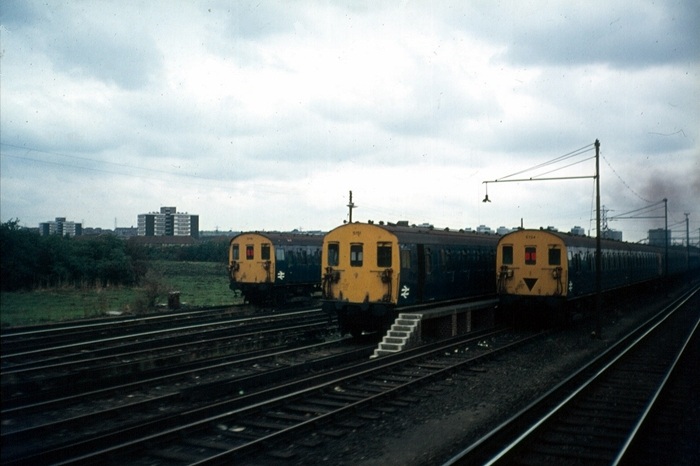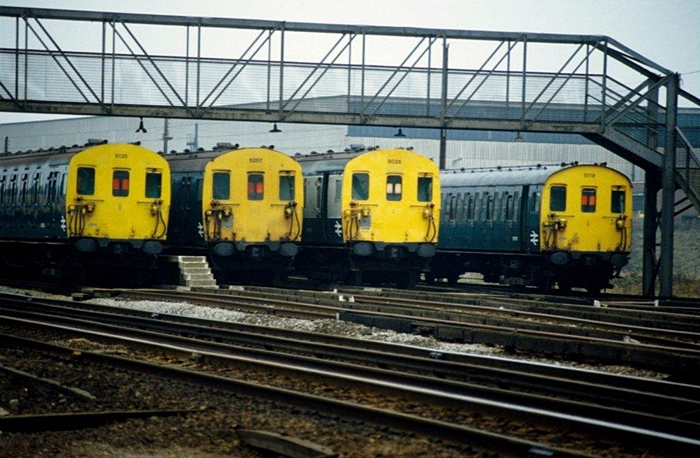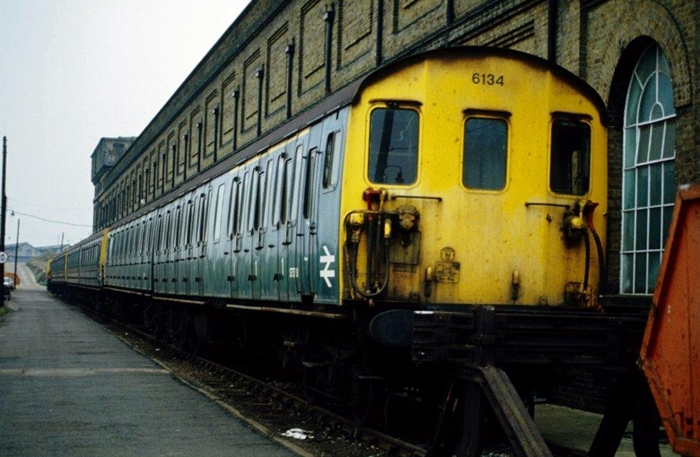
Slade Green Depot
SE&CR Shed Code: 4
TOPS Code: ''SG''
As recounted within the station section, Slade Green owes its whole existence to this single depot. By the end of 1897 the South Eastern Railway had finalised proposals for a large steam locomotive shed to house those engines which plied the London suburbs on the intensively-used North Kent routes. The company had considered enlarging the existing shed at Bricklayers Arms, this supplying locomotives for expresses out of Charing Cross and engines for freight traffic. Whilst additional land was available here, freight traffic was increasing and the spare space at Bricklayers Arms was instead selected to extend freight facilities. The plans for the new engine shed out on the Crayford marshes outlined a huge building, nearly 600 foot in length and housing ten parallel tracks, two of these which were dead-end and fed a repair shed on the north eastern elevation. An additional through line was planned to serve a coal stage on the south western shed elevation, which removed the need for a station goods depot when passenger platforms were commissioned in 1900. The whole building was to be built using the familiar yellow bricks employed by the SER for their stations, before the ''economical'' clapboard policy enforced by the company.
Construction of the shed on the nondescript marshland began in April 1898. The area's significance had come to light, if only in a small form, on 1st May 1895 when a triangular junction was opened with the Bexleyheath line, but there was little else of note. Within the initial forecasted depot budget of £55,500, the building of 145 houses was included, the work of which was subcontracted - the foundations of Slade Green were now set. Official completion of the engine shed, named ''Whitehall, Erith'', came on 27th October 1899, now under the auspices of the SE&CR, and a very impressive affair it was indeed. In addition to the characteristics already mentioned, the shed lines were fed by a pair of 50 foot turntables, flanking the building entrances - not even the primary main line sheds at Stewarts Lane or Ashford were built with such generous rotating provision! All shed roads could be closed off by individual sets of double wooden doors, and the first engines arrived in November 1899, by which time the total project had cost a whopping £74,500 - that equates to approximately £5,600,000 at today's prices. Expensive that may seem for a just a shed, but the cost did also cover the railway village. From the outset the engine shed had a total capacity, at least on paper, of 110 engines, these almost exclusively being the small suburban tanks which operated on the North Kent routes. All regular maintenance and heavy repairs were undertaken onsite, there being two five ton travelling cranes within the adjoining repair shed, and all shed roads incorporated an inspection pit. A huge 150,000 gallon water tank was supported on the north eastern elevation of the building, complete with water softener, and the whole shed roof was of ridge-and-furrow pattern. The advent of this depot allowed the smaller sheds at Woolwich Arsenal and Deptford to close, the pair having been sub to Bricklayers Arms.
Brief mention should be made of the Trench Warfare Light Railway in the area. This spurred off the running lines some 350 yards beyond the ''Dartford'' end of the engine shed, curving sharply to assume a north easterly heading across the marshes, where it met with the Thames Ammunition Works. About 1½ miles in length, the light railway opened in 1917, meeting the domestic network of the ammunition works at its end. This closed after World War I, but the internal rails of the works remained, as did a truncated section of the light railway, ⅓ mile long, between Slade Green and a refuse dump. This finally went out of use in 1924, but still sidings remained, curving out onto the marshes, just beyond the shed.
Now back onto the subject of the shed itself. Throughout the SE&CR era Slades Green, as it was now known, was regarded as a major motive power depot and indeed, the actual building was one of the largest on this company's network, only second to Stewarts Lane. After the Grouping, the Southern Railway began an electrification programme on those former SE&CR suburban lines, something the latter had planned, but not with the LSWR 660V third rail which was to be implemented. Early recipients were to be the North Kent routes, initially as far as Dartford. For this, the SR proposed in 1924 for the existing engine shed at Slades Green to be converted into an electric multiple unit depot. In addition to this, a new heavy maintenance building was to be built, this facing the Dartford end of the existing engine shed and being capable of undertaking all major repairs on the EMU fleet. This was to cost approximately £30,000 to build, which in today's prices is circa £1,140,000. This building was complete by the end of 1925, in time for scheduled electric working along the North Kent Line to commence on 6th June the following year (some electric services ran as early as 10th May due to a coal strike). The depot also became host to a mechanical carriage washer in 1935, a similar contraption also appearing at Orpington. Under Southern Region ownership, the former engine shed building was lengthened in June 1954 by 100 foot at its London end, to accommodate the longer EMU formations then being introduced. Platforms at stations were also being extended, as the 1952-introduced EPB units were formed into ten car trains to alleviate overcrowding (Bulleid's double-decker units being unsuccessful in this respect). The bricks used in the extension replicated those of the 1899 shed, but the roof here was ''humped'', rather than flat (the original ridge-and-furrow of the shed had been replaced with a flat roof during 1920s conversion work). With the station, the depot officially became ''Slade Green'' on 1st August 1953.
In 1990, some big changes were proposed. The most prominent of these was the demolition of the 1925 repair shed and the building of a brand new one in its place. This would accommodate eight dead-end tracks and function in virtually the same capacity as its predecessor, except for the fact that it would be tailor-made for the ''Networker'' fleet then being introduced. This new £20,000,000 maintenance depot was officially opened on 8th April 1991, with 4 EPB No. 5001 in attendance (and painted green) and a cab mock-up of No. 465001. The new building still had the facilities to carry out heavy repairs on the 1952 slam-door stock, a function it fulfilled until the final EPB withdrawals in March 1995.
31st July 1976

Taken from a Dartford-bound train, BR and Bulleid-designed EPB stock, wearing all-over ''Rail Blue'' livery, is seen stabled in those sidings on the ''up'' side of the running lines. In the background are the high rise flats of Erith. © David Glasspool Collection
1980

In the foreground is the double-track North Kent Line. Classic EPB stock of a previous era is seen stabled in those sidings which are positioned on the opposite side of the running lines to the main depot building. The units from left to right: Nos. 5135, 5257, 5026 (all Bulleid designs), and No. 5718 (BR design). © Wayne Walsh
1980

Lurking around the back of the former engine shed was 2-HAP No. 6134, wearing all-over BR Blue and complete with First Class compartment. This side of the depot structure was partially rebuilt in 1990, which included the reduction in height of the retaining wall and the removal of the water tank. Note, in the distance, the pitched roofs of the 1925 Heavy Lift Shop. © Wayne Walsh
Return to the Kent Rail Homepage or alternatively, check for Updates.
Website & Copyright information - Links - Contact the Webmaster
All content is copyright © David Glasspool unless otherwise stated